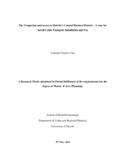| dc.description.abstract | In less than a generation, 70 % of the world’s population will be living in cities. Travel is a necessity
in urban areas but roads and other infrastructure have been unable to keep up with the needs of these
ever growing requirements. This has led to high levels of traffic congestion that threaten economic
productivity, environmental conservation and the overall quality of urban living. Nairobi City is not
exempt from these problems.
Several cities in the world have utilized Ropeways and Cable Liners as an innovative and attractive
approach to public transport. These have impressive features like ease in passing over barriers, rapid
installation, safety, high efficiency and simple integration with other means of transport.
The study aimed at investigating the possibility of integrating Arial Cable Transport (ACT) as a
means to supplement some of the solutions proposed for the reduction of congestion in Nairobi.
The literature review of the study covers urbanization and urban growth, urban transportation and
urban ACT. It analyzes ACT in Africa, developing world and the developed world. It also looks at
the benefits and challenges of ACT investigating the possibility of it being implemented in Nairobi.
The research was a non-experimental or survey research design. The key target population were
people who carry out their daily activities in the Central Business District (CBD). Data Collection
methods included Observation, photography, interviews, issuing of questionnaires and literature
review.
The study revealed that there has been a peak hour shift due to increase in traffic while the main
means used to access the CBD are personal vehicles and PSVs. Most people take approximately an
hour to access the CBD and about half the time when there is no traffic jam. Majority of those who
come to the CBD are youth (age 21-30) and are not happy with public transportation either due to
cost, reliability, timeliness and/or efficiency. Those who use rail transport are happy with the timing
and convenience but not with the comfort. Roads from the eastern side of Nairobi and the Mombasa
Road/Uhuru Highway corridor face the worst congestion while accessing the CBD. The study shows
that Nairobi residents want a transport system that is cheap, comfortable, has regular fares, timely,
polite crew and reliable. There is need to work on interconnectivity between the proposed MRTS and
the current paratransit.
The study also revealed that current public transport does not help people with disabilities. Those in
the public transport sector receive little training other than driving, first aid and simple mechanics.
There is no emphasis on NMT to access the CBD. The importance of reducing the number of private
vehicles entering the CBD is gaining recognition among both civilian respondents and PSV crew.
Most respondents were positive about the use of ACT with respect to usage, impact on traffic
congestion, value addition, creation of jobs and general embracement by members of the public.
The study recommends the urgent need for a sustainable MRTS that enables modal variety to access
the CBD with fixed and affordable pricing to people of all social classes and those with special
needs. Training of public transit crew is critical. ACT is a worthwhile means of urban transportation,
though routing has to be well selected based on corridor characteristics. There is, however, urgent
need for policy development for this to take place. It will be important to integrate the ACT with the
proposed MRTS. Further research should be done to investigate the potential of this system in
informal settlements. | en_US |

